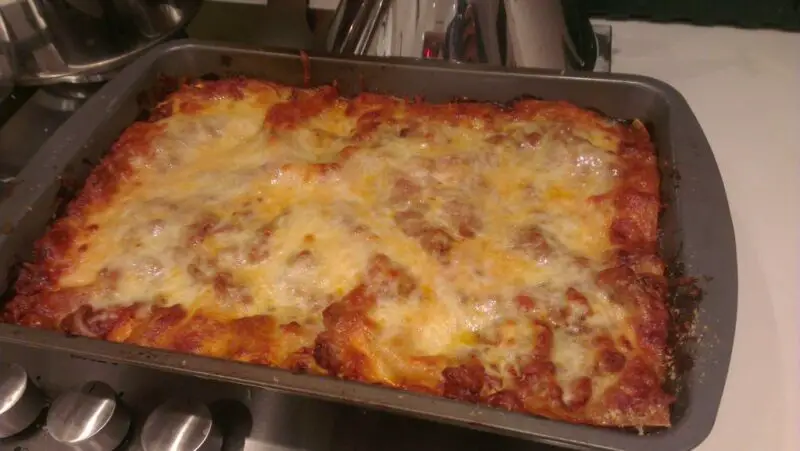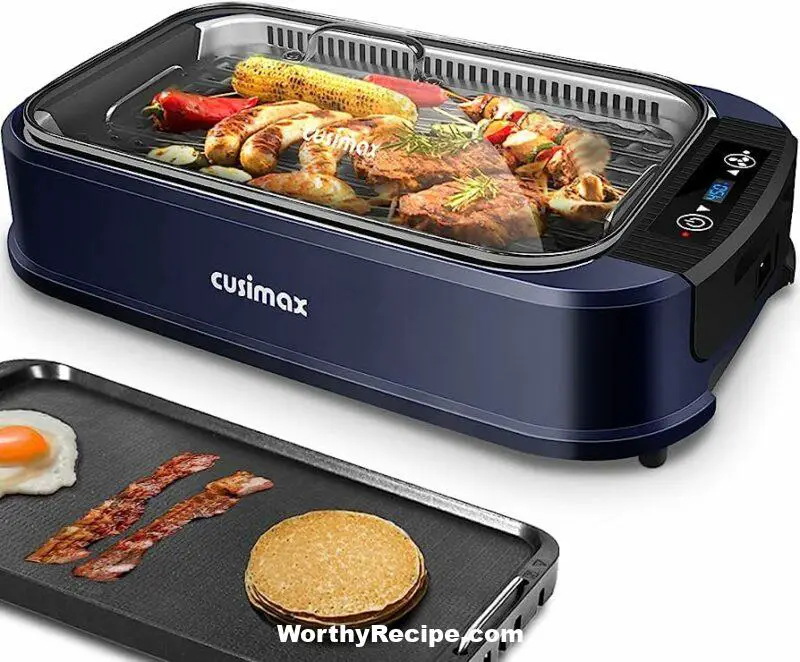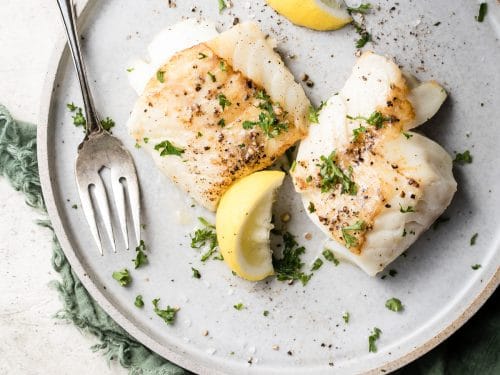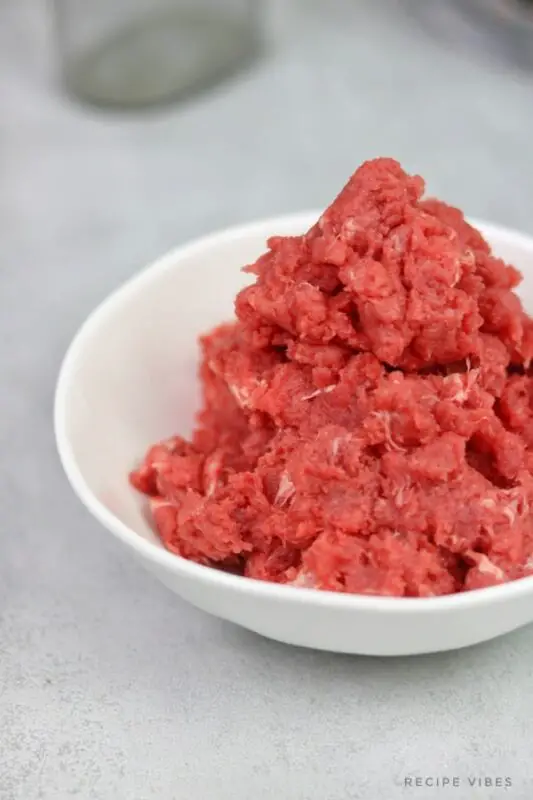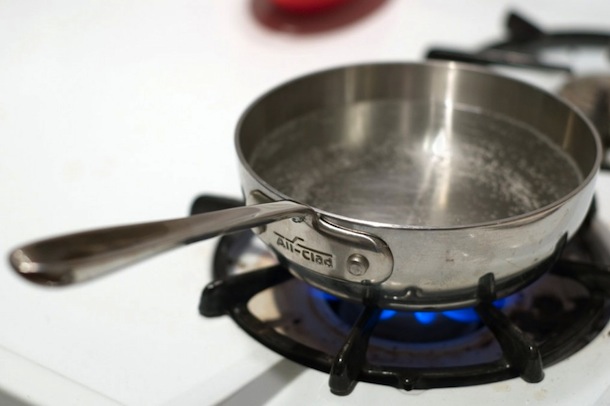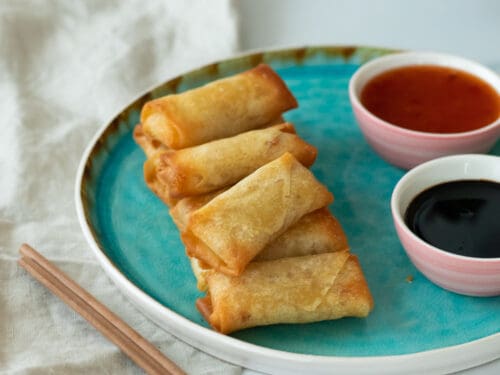Can I Bake Lasagna in a Cake Pan?
Lasagna is a classic Italian dish that has been enjoyed for generations. With its rich tomato sauce, tender noodles, savory meat, and delicious cheese, it’s no wonder why this dish has become a favorite all over the world. Traditionally, lasagna is baked in a casserole dish, but can you bake it in a cake pan?
Introduction
In this article, we’ll explore how you can bake lasagna using a cake pan. We’ll discuss the advantages and disadvantages of using cake pans versus traditional casserole dishes and provide tips on how to adapt your recipe for best results. Additionally, we will recommend some of our favorite recipes that use cake pans and answer some frequently asked questions about baking lasagna in a cake pan.
Types of Baking Pans and their Uses
When it comes to baking lasagna or other casseroles, there are several types of baking pans that you can use. These include:
- Casserole dishes
- Cake pans
- Glass baking dishes
- Metal baking dishes
Casserole dishes are wide and deep and are traditionally used for making lasagna. They come in varying sizes and materials (glass or metal) and usually have straight or slightly rounded sides to allow for the easy serving of the casserole.
Cake pans are usually round or rectangular with flat bottoms and straight sides. They come in different sizes (8×8 or 9×13 inches) and materials (metal or ceramic). They’re mainly used for baking cakes, but they can also be used for other baked goods like brownies and even lasagna.
Of course, the type of dish you choose to use will depend on personal preference and availability. However, these two types will be the focus of this article as cake pans are generally less often used for lasagne.
Advantages and Disadvantages of Baking Lasagna in a Cake Pan
Advantages of Baking Lasagna in a Cake Pan
More Options for Presentation
One significant advantage of using a cake pan to make lasagna is the more creative options available for presentation. Unlike with casserole dishes that only allow for layering ingredients side by side, a cake pan allows for stacking pieces vertically.
With a cake pan, you can create a layered or stacked design that can be cut into individual serving sizes. These new presentation options could be useful if you’re catering or making appetizers. It’s also enjoyable as it can further differentiate the cooking style and set your dish apart from others.
Easier Portion Control
Another advantage is the improved portion control. When using a casserole dish, it can sometimes be difficult to portion out servings precisely. In contrast, preparing lasagna in a cake pan allows each piece to be cut evenly, ensuring everyone receives an equal amount of lasagna per serving.
Reduced Potential for Leftovers
Baking lasagna in a cake pan also allows users to adapt their recipe according to how much they need instead of having excess leftovers after baking large portions. A typical lasagna recipe makes 8-10 servings when baked in a casserole dish. However, using cake pans means recipes can be adapted to yield fewer or more portions depending on need.
Disadvantages of Baking Lasagna in a Cake Pan
Potentially Uneven Cooking
One disadvantage of baking lasagna in a cake pan is the possibility of unevenly cooked sections. This is because cake pans have straight sides, and the corners tend to cook faster than the middle. Even when using heat distribution methods, (such as placing a baking rack or rotating the pan during cooking), it can be harder to get even baking when using a cake pan.
Risk of Overflow
Another potential problem with using a cake pan to bake lasagna is the risk of overflow. A casserole dish has deep sides that help contain the ingredients when they bubble up while baking; however, this cannot be so assured with cake pans, which often have shallower sides compared to casserole dishes. It’s important to ensure that you do not overfill your cake pans and leave some headspace for toppings, cheese, sauce or broccoli among others at the top of each layer.
Different Measurements Require Adaptation
The measurements used for baking lasagna can differ depending on whether you are using a casserole dish or a cake pan. When making lasagna in a cake pan, you may need to adjust the amounts of pasta, sauce, and filling you use to ensure everything fits correctly without overflowing. Knowing how much space your cake pan offers will help you make these necessary changes to prevent unwanted spillage while baking.
Tips for Baking Lasagna in a Cake Pan
Recommendations for Adapting the Recipe
To ensure that your lasagne bakes correctly when using a cake pan, here are some tips for adapting your recipe:
Ingredient Ratios
Consider adjusting the quantities of ingredients to fill the pan and ensure each piece has all the necessary flavors. You can reduce the amount of pasta or filling or increase the amount of sauce to ensure that everything fits in smoothly.
Cooking Time and Temperature Adjustments
You may need to adjust cooking times since the cake pan is made of different material than typical casserole dishes. Also, coverng the lasagna with foil for portions of the baking duration can prevent unwanted spillage. Consider preheating your oven to 375°F instead of the usual temperature of 350°F used for glass casserole dishes as these are thicker and usually have a more even heating surface and help prevent overflow. Timer this for 45-60 minutes for a baking time depending on serving size and layers.
Potential Need for Covering Pan
Cover the lasagne while baking it until almost at completion stage, this slows down overbrowning or drying out too early. Leave this off during last ten minutes of cooking to achieve an appealing golden brown crust on top.
Best Practices for Layering Lasagna in a Cake Pan
To layer lasagne correctly, start by greasing your cake pan with butter before starting the process then add olive oil to give it more moisture. This prevents sticking while adding more flavor to each portion.
Suggested Toppings
Toppings like grated mozzarella cheese, parmesan cheese, diced tomatoes and bell pepper or ham, spinach are options many use when making lasagne. However, when using cake pans, less traditional toppings such as roasted eggplant, mushroom or split sausages can work better due to their convenience in preparing lasagna portions that will be served in individual sizes.
Additional Ingredients (Herbs, Cheese)
Adding fresh herbs such as parsley or rosemary can improve the overall flavor of your lasagne. You can also top your lasagne layers with different types of cheese to make it even more tempting.
Best Recipes for Baked Lasagna in a Cake Pan
Here are some of our favorite recipes for making lasagna in a cake pan:
Lasagna Recipe 1 Using a Cake Pan
- 1 box lasagna noodles (cooked, keep ready)
- Two Jars of pasta sauce
- 1 cup cooked ground beef
- 1 cup shredded mozzarella cheese
- Salt and Pepper to taste
Instructions
- Preheat oven to 375°F.
- Take a cake pan and spread 2 tablespoons pasta sauce at the bottom.
- Add one layer of lasagna noodles on top.
- Add more pasta sauce, ground beef, and cheese on top of the first noodles layer, spread out into to ensure equal distribution.
- Add another later of lasagne on top and repeat Step 4 until you run out of your ingredients.
- Cover with aluminum foil midway through baking time –or covering from the beginning– and bake for approximately 45-60 minutes or until golden brownness is reached at the fourth level of layers.
- Serve hot or refrigerate if using from leftovers within three days.
Lasagna Recipe 2 Using a Cake Pan: Gluten-Free Option
- The wrap-up mimics pasta servings, but is made from vegetables
- 8-10 lasagna wraps made of cabbage leaves or zucchini slices (cooked, drained and kept ready)
- 1 tablespoon olive oil
- 2 cups of tomato pasta sauce
- 1 teaspoon dried basil leaves
- 1 teaspoon dried oregano
- 1/2 teaspoon salt, divided
- 5 cups of part-skim mozzarella cheese sliced, shredded or grated cheese (divided)
- One pound ground beef browned and drained well
Instructions:
- In a large saucepan, heat olive oil over medium heat. Add tomato pasta sauce along with dried basil leaves, oregano and salt and stir well.
- Slice cheese into thin strips.
- Add ground beef to the tomato pasta sauce mixture in the saucepan and stir well.
- Spoon two tablespoons of the mixture on the bottom of the foil-lined cake pan and spread well.
The following steps are repeated for as many as four layers depending on chosen volume of content.
5. Place one layer of the cooked vegetable-wrap at the bottom.
*The wrap choice can vary with preference. Some prefer eggplant or tofu cuts as a good mimic for noodle.
6. Add 1/4 of the tomato sauce mixture and spread it out evenly.
7. Layer one cup of shredded cheese.
*Any cheese choice that can be grated or sliced can be utilized. For a vegan option, dairy alternative cheese can suffice.
8. Repeat Process with the second layer of cooked vegetable-wraps,100g cheese and spreading out of another fourth of mixed meat tomato pasta sauce
9. Repeat that process for third and fourth level where possible.
- Cover with aluminum foil halfway through baking time, bake for 30-45 minutes until golden brownness is reached on the cheese layer and vegetables show clear heat signs.
- Serve hot, or refrigerate if using leftovers within three days.
Frequently Asked Questions about Baking Lasagna in a Cake Pan
How Do I Prevent My Lasagna from Overflowing While Using the Cake Pan?
You can prevent your lasagne from overflowing by not overfilling the cake pan. Ensure you leave space at each layer’s top for toppings –cheese, broccoli, meats etc.— and avoid stacking too many layers than what might overflow, this can protect your oven and improve your cooking results.
What Kind of Cheese Should I Use While Making Lasagna in a Cake Pan?
You can use any cheese you prefer or are used to; most lasagnas use shredded mozzarella cheese. You could also opt for a mix of parmesan, gouda, cheddar or ricotta cheese to give the lasagne an extra creamy and savoury taste.
Can I Use Gluten-Free Noodles While Baking My Lasagna in the Cake Pan?
Yes, you can use gluten-free noodles if you need to avoid a gluten allergy or intolerance. Make sure the noodles cook well before adding them to your chosen sauce or soup. Also consider that the gluten-free options spiralise, shred or boil veggies as substituents for standard lasagne noodles.
Conclusion
In conclusion, baking lasagne in cake pans has become more popular in recent times and is a valid alternative for producing excellent results with new presentation opportunities. Even though there are minor challenges when using cake pans such as overflowing and uneven cooking, following tips and cookery instructions provided would allow users to avoid them accordingly.
We’ve discussed recommendations for adapting recipes when preparing lasagne in cake pans; also itemised best practices for layering lasagne evenly to create better results. We hope you’ll explore different options and find the perfect recipe that works for you!
Frequently Asked Questions
Can I use a cake pan to bake lasagna?
Yes, you can bake lasagna in a cake pan. While a traditional lasagna dish is deeper and comes with handles that help with serving, a cake pan is shallow but still perfect for baking lasagna. After all, it’s just a matter of getting creative with your cooking.
Won’t the sauce or cheese spill over the sides of the cake pan?
No, if you use a cake pan that’s the same size as what a recipe calls for (typically 9×13 inches). If you are using homemade noodles instead of store-bought ones, make sure they fit in the container so that they don’t stick out and cause any boil-overs.
What’s the difference between baking lasagna in a traditional dish vs. a cake pan?
The differences come down to size and shape. A traditional lasagna dish usually has higher sides and handles, making it more convenient for serving after baking. A cake pan, on the other hand, is less deep and won’t give you as many portions. However, it’s perfect for those who don’t need to serve an army with their baked pasta.
What should I do if I want to add more layers to my lasagna?
If you want to add more layers than your cake pan allows for, then consider using two pans instead of one. Bake one first, then slide onto a platter for cooling before continuing with another layer or two in the second pan. This will keep things manageable and avoid creating an overflowing mess in the oven.
